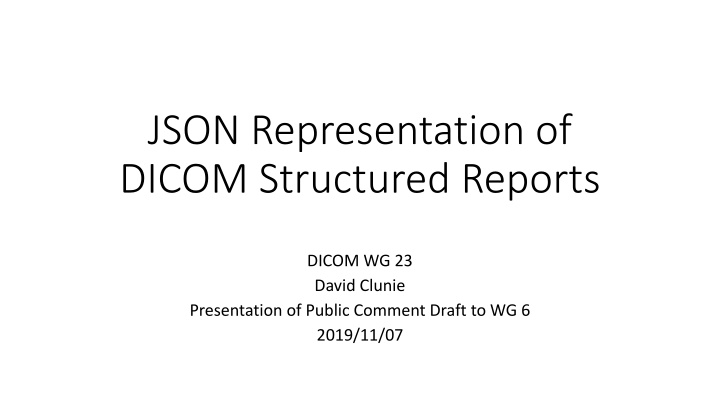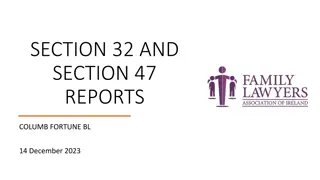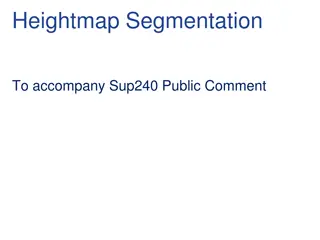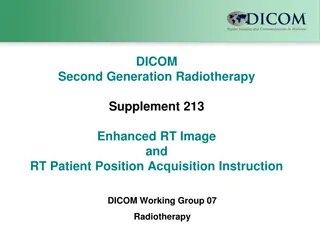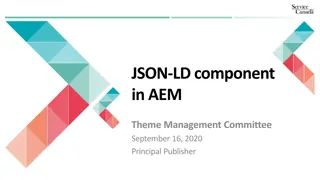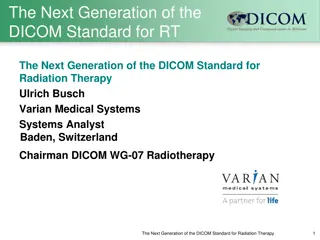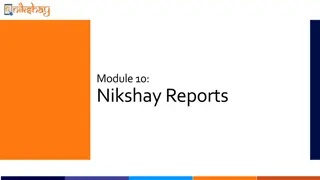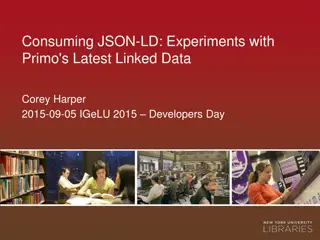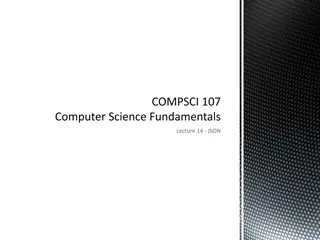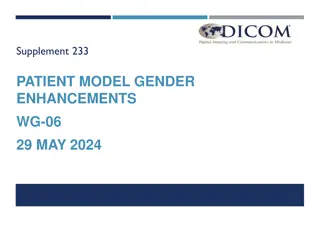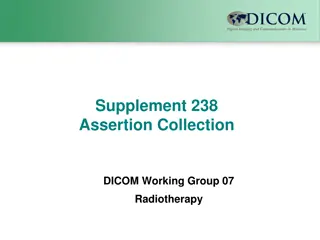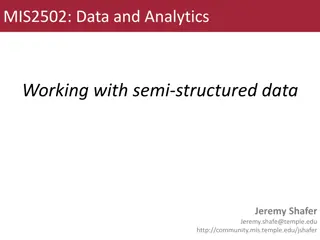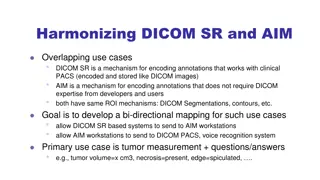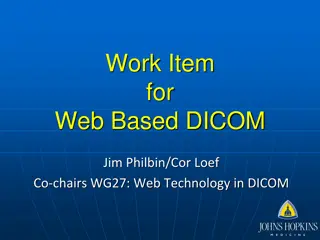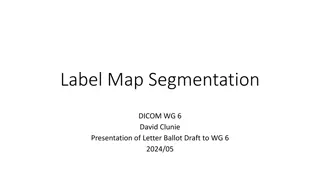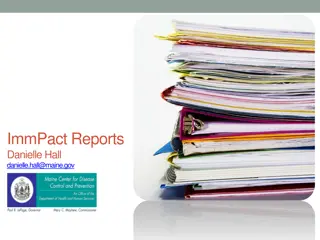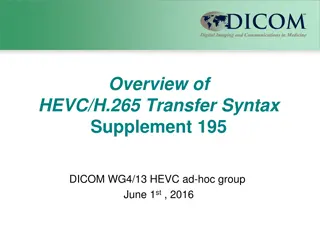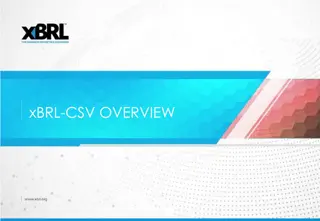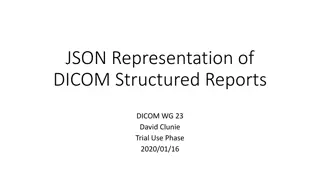JSON Representation of DICOM Structured Reports
DICOM Structured Reports play a crucial role in encoding measurements, results, and image references in AI applications. However, ensuring interoperability of annotations is now more critical than ever, as semantic annotations have significant value beyond their primary use cases. The cost implications of creating, recreating, and processing annotations underscore the necessity for standardization and interoperability, particularly in the context of AI-generated content.
Download Presentation

Please find below an Image/Link to download the presentation.
The content on the website is provided AS IS for your information and personal use only. It may not be sold, licensed, or shared on other websites without obtaining consent from the author.If you encounter any issues during the download, it is possible that the publisher has removed the file from their server.
You are allowed to download the files provided on this website for personal or commercial use, subject to the condition that they are used lawfully. All files are the property of their respective owners.
The content on the website is provided AS IS for your information and personal use only. It may not be sold, licensed, or shared on other websites without obtaining consent from the author.
E N D
Presentation Transcript
JSON Representation of DICOM Structured Reports DICOM WG 23 David Clunie Presentation of Public Comment Draft to WG 6 2019/11/07
http://medium.com/adhive/disruptive-ai-controlled-advertising-cd90a07452cbhttp://medium.com/adhive/disruptive-ai-controlled-advertising-cd90a07452cb
Annotation interoperability matters now Previously: little incentive to annotate few tools to create or view annotations annotation interoperability was a low priority for product managers presentation rather than semantics were the priority for annotation tools Now: semantic annotations have (real monetary) value beyond primary use case recognition of existence of unanticipated re-use cases annotations are expensive to create/recreate retrospectively more expensive to process if proprietary rather than OTS standard AI-generated annotations need to be interoperable for display interactive AI requires interoperable annotation exchange AI vendors unlikely to be the same as scanner/PACS vendors mix and match
DICOM SR and AI DICOM SR is a generic solution for: fundamental encoding of measurements, categorical results, using codes and referencing images, waveforms as well as spatial and temporal coordinates reusable sub-templates for specific scenarios that are common to different use cases and applications generic root level templates for non-specific measurements (e.g., TID 1500) linking other objects related to results and measurements (such as SEG, Parametric Map and RWVM) Specific templates for: traditional CAD applications that are relevant to AI traditional human operator measurements that may now be made by AI
DICOM SR and the developer Traditional DICOM SR encoding requires use of a toolkit and an API with a non-trivial learning curve (binary encoding intractable by hand) AI algorithm developer may not need to know about the composite context (patient/study/series +/- workflow metadata) of the encounter Impedance mismatch between PACS-orientated DICOM image in, DICOM SEG + SR out Algorithm-developer orientated PNG in, PNG + JSON out Even XML is deemed excessive/too complicated by AI developer community DICOMweb JSON encoding is also intractable for SR, since it is hexadecimal tag, individual data element orientated (no SR content item abstraction)
Goals for Simplified DICOM SR in JSON Full-fidelity round trip with actual DICOM SR for all constructs (any template) Simple (enough to hand write or copy from examples) Compact (even terse) Understandable (relatively) Unambiguous (easily parsable) Leverage any existing actual or de facto JSON or evolving AI standards Platform independent Capable of encoding extracts separated from composite context (such as without header rather than content tree, image library, etc., which could be added by separate tool/pass)
Non-Goals for Simplified DICOM SR in JSON Not an alternative/competitor to existing PS3.18 Annex F JSON for non-SR objects Not an alternative/competing persistent form to be serialized and stored, as opposed to binary DICOM SR stored in PACS/VNA Not an abstraction of template-specific concepts or alternative information models for similar content No template-specific constraints or optimizations Not a means for defining a new validation mechanism for SR content (template-defined), but does not prohibit it
Pipeline to add missing stuff to JSON Just Number, Coordinates and Image Reference + Image Library and Evidence Sequences + Lesion Identifiers + Composite Context Patient-Study Aware System DICOM Image Aware System AI Algorithm Lesion Manager PACS
Design Decisions Business Names No hexadecimal numbers for header attributes leverage DICOMweb JSON encoding but with PS3.6 keywords rather than numeric tags Abstract the content items (i.e., name-value pairs), as if they were attributes, rather than exposing their component attributes No obscure alphanumeric codes in content tree use business names concept from Green CDA (not dissimilar to JSON-LD) Codes are defined in separate business names JSON file that acts as a dictionary do not need to be standardized (but may be in future, like keywords)
Design Decisions JSON Structure Use JSON Objects where identity is important but not order Use business name as name of JSON Object s name-value pair Use JSON Arrays to preserve order Use JSON Arrays to allow sibling JSON Objects with same name Use a JSON Array to encode children Collapse unnecessary JSON Arrays into single value when possible for business names and top level data elements Omit data element VR if it can be found in dictionary or business name file Omit explicit value type and relationship type if they can be deduced from context, or defined in the separate business names file Add annotations (specific object names starting with @ symbol) to resolve ambiguities, and to provide target and source for by-reference relationships
Current Discussion and Open Issues Some folks are distressed by the terseness and nesting of objects and arrays Proposals for clarity at the expense of compactness e.g., include annotation to indicate type rather than relying on positional parameters, such as for graphic type, coordinates, etc. specified as open issue Concern about anonymous concept names (no name for name-value pair) allowed by both SR infrastructure and many templates, esp. for IMAGE and SCOORD content items harmless but lead to lots of nesting Adding higher level abstractions (than content item level) might address some of these concerns, but also make for a more complicated parser Proposal to substitute keywords/business names for UIDs (e.g., SOP Class)
Out of Scope (for this development cycle) A DICOMweb API to transform JSON SR to/from the standard binary DICOM SR persistent form (in a WADO-RS or STOW-RS application/dicom+json like manner, e.g., application/x.dicomsr+json ) A DICOMweb API to access, create or modify the DICOM SR content tree abstraction (cf. the existing RetrieveMetadata individual DICOM attribute level access) A DICOMweb API to create and manage individual (or sets of) annotations separately from the storage/retrieval of entire DICOM SR object A DICOMweb API to perform/manage the various steps of the authoring pipeline that adds lesion management, image references and descriptions, and patient/study/series/workflow composite context
